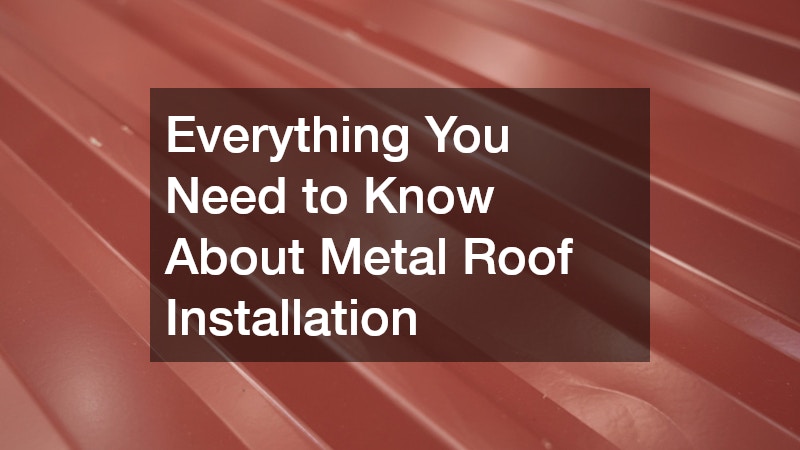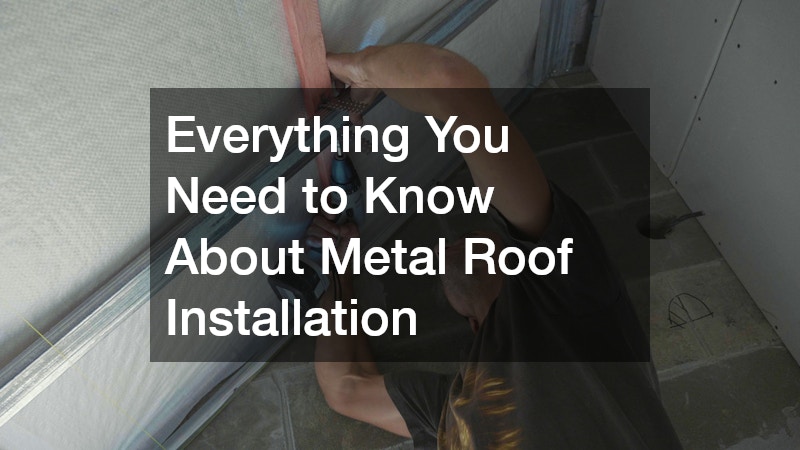In this comprehensive guide, we will explore the essentials of metal roof installation, discussing the benefits and common inquiries associated with this popular roofing option. Metal roofing has gained traction among homeowners due to its numerous advantages, and understanding these benefits can aid in making informed decisions.
What Are the Benefits of Installing a Metal Roof?
Durability and Longevity
One of the most significant advantages of metal roofing is its outstanding durability and longevity. Metal roofs can last between 40 to 70 years, depending on the material, far outlasting traditional aspandlt shingles, which typically last 20 years at most.
This long lifespan stems from metal’s strong resistance to weather elements such as wind, rain, and snow. Homeowners who choose metal roofing are investing in a solution that will withstand the test of time.
In addition to its long lifespan, metal roofing offers superior strength, standing up to impacts and daily wear and tear with ease. Unlike other roofing materials which may crack or warp under pressure, metal roofs maintain structural integrity even under the most challenging conditions. Moreover, many metal roofs are coated to resist corrosion, preventing rust and damage from moisture over decades of use.
Another aspect contributing to the durability of metal roofing is its fire resistance. Most metal roofing types carry a Class A fire rating, the highest possible, ensuring minimal risk in case of a fire. This feature not only protects homes but can also provide peace of mind for homeowners aware of their property’s vulnerability to environmental hazards. Therefore, when considering a durable roofing option, metal roofs stand out as a preferred choice.
Energy Efficiency
Metal roofs are known for their energy efficiency, providing advantages that can lead to significant cost savings. One of the key components of this efficiency is metal’s reflective properties. Metal roofs are adept at reflecting solar radiant heat, which can reduce cooling costs by 10-25%. During the summertime, this reduction in heat absorption makes a noticeable difference in indoor comfort.
Beyond reflecting heat, metal roofing can be modified or supplemented to enhance energy efficiency. Many homeowners opt to install cool metal roofing, which meets Energy Star specifications. These roofs have specialized pigments that reflect the sun’s ultraviolet rays, lowering roof surface temperatures and reducing heat transfer into the house. If paired with proper insulation, metal roofs can lead to a yearly decline in energy bills.
It is also worth noting that metal roofs can support the installation of solar panels more easily than some traditional roofing options. Roof-integrated solar systems can complement a metal roof’s energy-saving properties. When solar panels are installed, homeowners not only lower their utility costs but may also benefit from incentives or tax credits. Ultimately, the energy-efficient nature of metal roofs helps them pay for themselves over their lifespan through reduced energy expenditure.
Environmental Impact
The environmental impact of metal roofing is generally positive, as these roofs contribute to sustainability efforts in multiple ways. Metal roofs are often composed of recycled materials and are themselves recyclable, making them a green option compared to conventional roofing materials. With the potential to be made up of up to 95% recyclable content, metal roofs minimize waste reaching landfills during initial installation or after their long service life ends.
Additionally, the longevity of metal roofs reduces the need for frequent replacements, leading to fewer raw materials being utilized over time. Prolonged product life cycles are beneficial for the environment because they decrease the demand for roof manufacturing processes, which often involve energy-intensive operations that emit greenhouse gases. The combination of renewability and durability makes metal roofing a smart choice for environmentally-conscious consumers.
Besides their recyclable properties, metal roofs can also enhance the overall energy efficiency of homes, which in turn has environmental benefits. By improving energy performance, homes with metal roofs may require less energy production from power plants, reducing the carbon footprint associated with electricity generation. This eco-friendly advantage aligns with the growing trend towards sustainable housing solutions and reflects a future-forward approach to home improvements.
How Do You Install a Metal Roof?
Preparing the Roof Surface
Proper preparation of the roof surface is crucial for a successful metal roof installation. This phase involves removing the old roofing material to inspect the underlying structure for any signs of damage or decay. If necessary, repairs should be made to the decking or support structures to ensure a solid foundation for the new metal roof. Skipping this essential step can compromise the performance and longevity of the roofing system.
Once the underlying structures are verified to be sound, a layer of roofing underlayment is installed. This underlayment acts as an additional barrier against water infiltration and weather-related damage. While different types of underlayment exist, synthetic barriers are often preferred for metal roofs due to their durability and superior moisture protection. Correct installation of the underlayment is key to maintaining the integrity of the roofing ensemble.
One of the final preparatory steps is to ensure that all necessary materials are on hand and in good condition. This includes the metal panels, fasteners, and additional accessories such as flashing and ridge vents. Keeping organized and having a clear understanding of the roofing layout will facilitate a smoother installation process. Assembling all components before beginning the installation also helps avoid unnecessary delays once work has commenced.
Choosing the Right Materials
Choosing the right materials for a metal roof involves several important considerations that can impact both the aesthetic appeal and functional performance of the roof. Metal roofing comes in different types such as steel, aluminum, copper, and zinc. Each type offers unique be,nefits; for instance, aluminum is highly resistant to corrosion and ideal for coastal environments, while steel provides strength and an economical price point.
Besides selecting the type of metal, it is crucial to choose a finish and color that complement the building and enhance curb appeal. Many manufacturers offer a wide range of color options with coatings that enhance durability and reflectivity. Glossy finishes can amplify energy efficiency by reflecting sunlight while matte finishes may offer a more subtle look. Whichever choice is made, it is wise to verify that the materials have a warranty to ensure long-term satisfaction.
Finally, another key factor when choosing materials is to consider local building codes and climate conditions. Some regions may impose regulations on the type of roofing materials used, particularly in areas prone to severe weather events like hurricanes. Consulting with a licensed roofing contractor or supplier provides valuable insight, ensuring the selected materials are appropriate for the property’s location and weather demands.
Installation Process Overview
The installation process for a metal roof generally starts with measuring and cutting the metal panels according to the roof’s dimensions. Proper measurement is essential to minimize waste and ensure an efficient installation. Panels need to be custom-fitted and aligned with precision to prevent gaps or overlaps that could lead to leaks or poor insulation performance.
During installation, panels are fitted from the eaves upward, overlapping each subsequent panel to enhance the shedding of water. Fasteners secure the panels in place, and care must be taken to use the appropriate screws and clips recommended for the metal type. Incorrect fasteners can lead to damage or compromise the roof’s integrity over time. Ridge caps and flashing are added as finishing touches, preventing water ingress at roof junctions and terminations.
Lastly, following the correct installation guidelines is critical to ensure that the roof performs as expected. Even small errors or deviations from the recommended practices can lead to issues such as water leakage or reduced lifespan. As an additional safeguard, many manufacturers require installation by a certified professional as a condition of their warranty. Therefore, collaborating with experienced and knowledgeable contractors is recommended to ensure top-notch results.
What Are the Costs Associated with Metal Roof Installation?
Material Costs
The cost of materials for a metal roof can vary significantly based on the type of metal selected and the complexity of the roof’s design. Steel and aluminum are often more affordable options, with per-square-foot costs ranging widely based on thickness, finish, and additional features like seam styles. Premium materials like copper or zinc may require a higher initial investment but offer distinct aesthetic and longevity benefits.
In addition to the metal panels, other material costs include underlayment, fasteners, and accessories like flashing and vents. These components are essential for a complete and effective roofing system, contributing to the total cost. Quality should not be compromised in these areas, as they play a crucial role in the roof’s performance and lifespan.
Purchasing materials from a reputable manufacturer can also impact costs. Choosing suppliers with strong warranties and proven product quality ensures that investments are protected. Although initially more expensive than other roofing types, metal roofing’s durability and energy efficiency typically lead to savings in maintenance and energy expenses over time.
Labor Expenses
Labor costs can form a significant portion of the total expense associated with metal roof installation. Skilled technicians are required to perform detailed and precise work, as metal roofing differs in installation compared to traditional shingles. The complexity of the roof design, including pitch, height, and number of penetrations, can also influence labor costs.
Hiring an experienced contractor who understands the nuances of metal roof installation is crucial. These professionals provide valuable insight and ensure adherence to best practices, leading to fewer installation errors and a longer-lasting roof. While labor costs may appear higher initially, the assurance of quality workmanship provides long-term savings by preventing costly repairs or premature roof failure.
Obtaining multiple quotes from different roofing contractors is advisable for homeowners seeking competitive pricing. This approach helps individuals understand the market rate and identify reputable contractors whose services align with required standards. Remember, the cheapest option may not always be the best, as poor-quality work can lead to problems that demand extensive fixes later.
Long-term Savings
Despite the significant upfront costs of materials and labor, metal roofing often provides long-term savings to homeowners through several channels. The longevity and durability of metal roofs mean that replacement costs are deferred much longer than other roofing types. Homeowners save on the cost of reroofing, which, in traditional systems, may occur every 15 to 20 years.
Energy efficiency is another arena where metal roofs demonstrate cost-saving benefits. By reflecting solar heat and enhancing overall home insulation, metal roofs can significantly reduce home heating and cooling expenses. Energy savings contribute to year-round relief for the homeowner’s utility budget, noticeably reducing the energy bills over the roof’s life.
Lastly, when it comes to insurance, some providers offer discounted rates for homes with metal roofs due to their resistance to weather damage and fires. While these discounts vary by provider and region, the reduced risk of extensive weather-related damage can lead to lower premiums, supplementing overall savings. Thus, while the initial investment for a metal roof may be higher than other options, the comprehensive benefits greatly offset those early expenses over time.
Understanding the key aspects of metal roof installation can help homeowners make informed decisions about their roofing needs, balancing cost, efficiency, and durability. Investing in a metal roof means choosing a durable, energy-efficient, and environmentally friendly option that offers long-term savings. By carefully selecting materials, hiring experienced professionals, and considering the total cost of ownership, homeowners can enjoy peace of mind and a high-performing roof for years to come.


